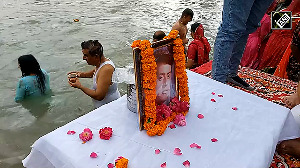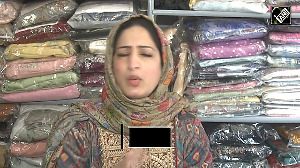Bharatya Janata Party president Rajnath Singh’s career is punctuated by important milestones. He has been elected to the Uttar Pradesh legislative assembly as well as the legislative council, has served as the state’s education minister and chief minister, has twice been co-opted in the Union Cabinet and now, been placed as president of the Bharatiya Janata Party for the second time.
That apart, he has often performed overt and covert roles on the orders of the Rashtriya Swayamsevak Sangh.
The late 1980s and early 1990s in Uttar Pradesh were the years of Kalyan Singh, a Lodh (a Hindu Rajput caste) with a strong RSS background. After he was sworn in as chief minister in June 1991, Kalyan travelled to Ayodhya with his entire Cabinet to promise that his government would build a Ram temple at the same spot where Babari Mosque stood.
Among those who took the pledge was Rajnath, the education minister. One of his first moves as minister was to bring, through an ordinance, the anti-copying law, making copying a non-bailable offence: which meant the onus of proving oneself innocent was on the accused.
Kids of 14 and 15 were sent to jail on charges of copying in examinations. The pass percentage in Class X in 1991 was 58.03; in 1992, after the anti-copying law was put in place, it slipped to 14.7.
Singh had to pay for his convictions: he contested the assembly election from Mohana, a student-dominated constituency near Lucknow in 1993, and was defeated comprehensively.
In 1994, he was sent to Delhi as a member of the Rajya Sabha. This was largely a result of energetic exertions with the RSS. Rajnath would get the tour programme of RSS functionaries in advance, await them at the railway station, hop on to the train and accompany them wherever they were going, thus ensuring brand recall.
Back in Lucknow, Kalyan was getting distracted -- mostly by lady colleagues. Rajnath kept senior party leaders in Delhi up to speed on happenings in Lucknow including the ‘pure’ feelings that Kalyan nurtured towards a fellow lady legislator.
The puritanical RSS could countenance financial corruption, maybe even overlook it. The state unit was headed by Kalraj Mishra; but he was unable to pull on effectively with Kalyan. This, too, was communicated to the central leadership. In 1997, Rajnath was appointed president of the state unit.
His moment of glory came the same year when the experimental sharing of power between the Bharatiya Janata Party and the Bahujan Samaj Party -- a rotating chief ministership through prior arrangement -- collapsed. As president, he was able to engineer splits in both the BSP and the Samajwadi Party, in what was then called Operation Shakti. The members of Legislative Assembly were brought to Delhi in planes lent by an obliging industrial house.
In 1999, Kalyan was removed as chief minister and the ageing and forgetful Ramprakash Gupta installed in his stead. To placate all sections and factions in the BJP, Gupta had a 96-member council of ministers -- so it was natural he should forget the names of some ministers.
As chief minister, Gupta was just not effective. So Rajnath helpfully created a situation where the RSS suggested that he be made chief minister. That’s how in October 2000, Rajnath became the chief minister of Uttar Pradesh. Of course, this cost him his friendship with Kalyan (Gupta was expendable).
But it suggested a new character trait: Rajnath could never be a trusted ally, though he could be counted upon to be an unexpected friend. Before he relocated to Lucknow, Rajnath had been appointed minister for surface transport in the Atal Bihari Vajpayee Cabinet.
Here, Rajnath left little impact. Because Vajpayee’s plan of creating infrastructural connectivity had led to the idea of the Golden Quadrilateral -- the highway that would link all four corners of India -- Rajnath found there was plenty to do and little to think about.
But he managed to get into a squabble with the chairman of the national highway Authority of India and went complaining about him to Vajpayee who told him his complaints were not seemly. “One should not fight with the tools one uses,” he told Rajnath in Hindi.
In RSS politics, Rajnath found himself backing the wrong horse time and again. He was, not unnaturally, opposed to Narendra Modi, and told RSS he disapproved of the way Modi had separated the Gujarat administration from it.
But RSS and, by extension, Rajnath, found themselves helpless because Modi won election after election. On another occasion, the RSS and Rajnath tried to tick off Bihar Deputy Chief Minister Sushil Modi for giving in to ally Nitish Kumar’s hectoring.
But Modi stood firm. Not only the RSS, even Rajnath couldn’t hurt him politically. In 2005, he was appointed the party national president. His lowest point came in the run up to the Uttar Pradesh elections in 2007.
His son got a BJP nomination from Chiraigaon. At first Rajnath, having engineered the nomination, weakly rebutted suggestions that BJP was not as opposed to family rule and regency as was commonly believed. But when it became clear that BJP was going to lose the assembly elections, he said he had opposed family rule all his life and got his son to step down, making a virtue of a liability.
Because Rajnath has had a clean image -- for years, his medium of transport was a broken-down Fiat car which regularly had to be pushed to start -- RSS, BJP and leaders allowed no dirt to stick to him.
Does he have the same leverage with the party today?
Delhi is not Lucknow, this is not 1987, and Advani continues to be a force in the party. And then there is Modi. This makes for a different kind of politics in BJP now.










 © 2025
© 2025